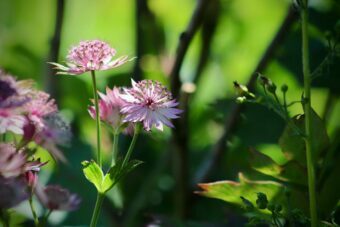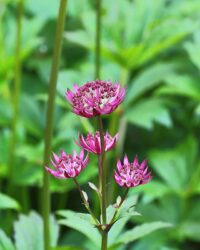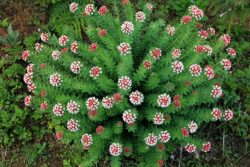In this article, we will discuss how to grow the cottage favourite of Astrantia in containers. Astrantia is a genus of herbaceous perennials that belong to the Apiaceae family (the celery family). It is found throughout Central, Eastern and Southern Europe, but not found in the Colder Northern parts. Astrantia is a small genus, where only 11 species are known to exist and most are not seen in the garden, especially in the UK. It has the common name of Masterwort but it can be sold as Melancholy Gentleman or Hattie’s Pincushion.

This is a perennial for the shade. In early spring the deeply divided leaves that are either dark green or variegated starts to appear. In June or July above these leaves, flower heads appear that come in shades of green, red, or pink and often have tiny flowers at the centre and a skirt of papery bracts. This gives the flowers an unusual appearance but they do stand out,
What is great about this plant is that multiple colourful cultivars exist, making it a great choice for the container garden.
Find out how to grow this perennial in containers in this article.
GROWING ASTRANTIA IN CONTAINERS
You have a choice of how to grow Astrantia, either from seed but usually, it is grown from garden-ready plants.
GROWING ASTRANTIA FROM SEED
To grow Astrantia from seed you will need to sow it in early spring indoors or in late autumn. First, fill a seed tray with a good quality seed compost and then add some water until the compost is moist. You will need to scatter the small seeds thinly on the surface of the compost and do not cover them as it needs light to germinate. You will then need to cold stratify by placing the tray and seeds in a fridge for 4 to 6 weeks. After this time, you will need to return the seed tray to a warm window sill and it should germinate.

It may take some months but if it does not, you may need to cold stratify once more. Allow the seedlings to grow on and once the plant is large enough to handle, you can prick them out into 7.5cm individual pots full of multipurpose compost. Place it in a cool room and from late summer or early autumn, you can start to harden them off for 14 days before planting them out in containers.
YOU CAN TREAT SHOP-BOUGHT AND HOME-REARED THE SAME WAY
At this stage, you can treat garden-ready and home-reared plants in exactly the same way. First, choose a container that will suit your plant in question and will go with your preferred container garden scheme.
Whatever you choose make sure you have plenty of drainage holes. Fill the container with a good quality multipurpose compost to 5cm of the top rim. Dig a hole at the centre of the container slightly larger than the root ball it came in the original container. Drop the plant in so that the top of the root ball is at the same level as the top surface of the compost, Backfill with the growing media making sure that no gaps remain, using more compost if necessary. Water well and firm the plant in.
GROWING CONDITIONS
Place the container in light shade as it does its best under these growing conditions. You will need to water regularly, especially so when 5cm below the top surface of the compost feels dry to the touch. It is better to keep it on the moist side rather than too dry.
Every spring, you will need to give the plants an annual dressing of slow-release fertilizer to give all the nutrients to get them through the growing season. At the time of planting, you can add a layer of well-rotten manure to act as a mulch to preserve moisture.
The attractive seed heads can be left overwinter but they do have a tendency to self-seed everywhere. The only problem is that they easily crossbreed with other varieties to form unknown plants. To avoid this, it is best to cut the plant to ground level after the first flush to stimulate new grown and new flowers in late summer.
PESTS AND DISEASES
The young shoots are very attempting for slugs and snails, it is therefore recommended that you protect your plants from this by using slug pellets or woolly deterrent matting.
They can suffer from powdery mildew which can be avoided if you water regularly and you ensure that you have good air circulation around the plant. It is better to cut affected plants rather than rely on fungicide.
VARIETIES TO GROW
You will find most Astrantia sold in the UK are based on the Astrantia major described above.

The following cultivars are recommended:
‘Moulin Rouge’ has vivid red pincushion flowers with a matching red skirt.
‘Venice’ has light red/pink pincushion flowers with a light pink skirt.
‘Milano’ is a prolific flowering plant with red pincushion flowers with a lighter red skirt.
‘Star of Billons’ has light purple pincushion flowers with a green skirt that surrounds them.
‘Star of Love’ has light red pincushion flowers with an even darker red skirt.
‘Florence’ has matching light mauve pincushion flowers with a mauve skirt.
‘Roma’ has a light pink skirt with a pincushion of pink flowers at the centre.
A variegated form that has cream-splashed green leaves is ‘Sunningdale Variegated’.
An alternative to A. major is A. maxima which are taller and have pink flowers.
CONCLUSIONS
In this article, we have discussed how to grow the pretty and dainty perennial of Astrantia in containers. They not only look good, but they are also easy to care for and are relative pests and diseases-free if you can keep the slugs and snails from eating the young leaves. The flowers are a great addition to the garden due to the look they bring but they are great to have in containers as well.
If you have any questions or comments that you wish to make on growing Astrantia in containers, please do so in the comment box below.
Happy Astrantia growing.
